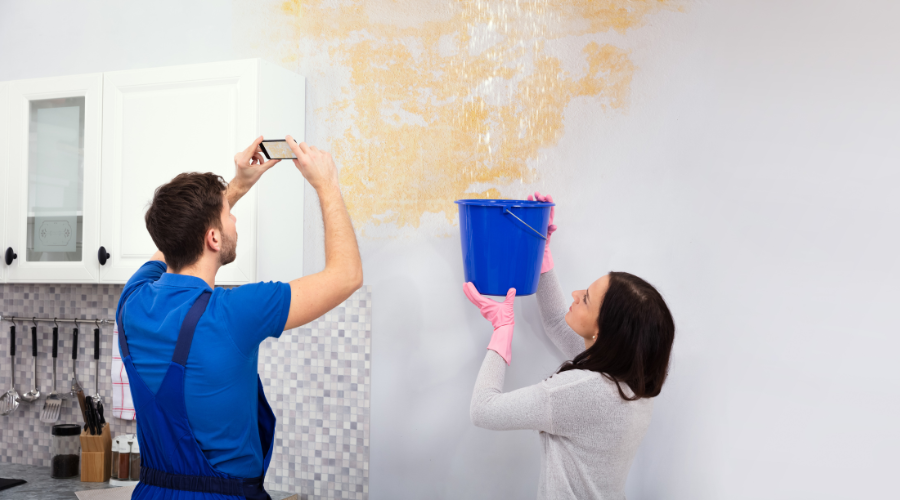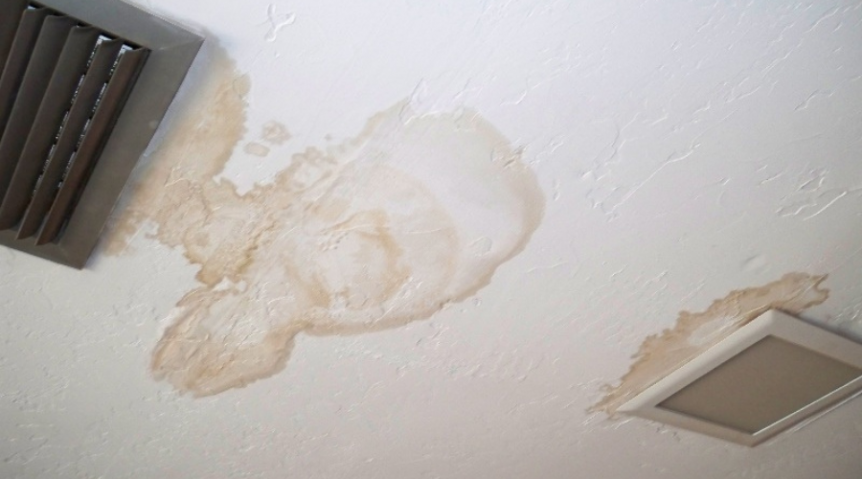Homeownership, while a privilege, comes with its own set of hurdles. Water damage from the AC vents is one of them. While the AC stands between the homeowner and the intense summer heat, it can at times malfunction. Here’s how to respond when water damage occurs from the condensation.
Why does the AC cause water leaks from the ceiling?
All AC systems are built with several individual components to cool the home. However, leaks can come from the AC system when parts of it do not function as they should. AC units may be installed in the attic in some homes, making leaks apparent on the ceiling below.
For example, the AC may leak due to air filters that have become dirty and require replacing. A clogged drain or cracked drain pan in the AC system can likewise cause a leak. If insufficient levels of refrigerant remain in the AC unit, a leak can occur.
In unmaintained AC units, the evaporator coils can become covered in dust and debris. A leak can be a signal to the homeowner that the coils need to be cleaned. Condensation buildup in the ductwork can also lead to a leak. In general, poor maintenance causes AC leaks.
Is water dripping from the AC dangerous?

While frustrating, water leaking from the AC is not dangerous. However, the constant drip of moisture will cause serious water damage—a costly and time-consuming repair. Small amounts of water from the AC are not hazardous to humans, but a coolant leak can be dangerous to people and the environment.
If the refrigerant leaks through the vents, for instance, it can cause a wide range of problems to occupants in the home. Exposure to the substance can cause dizziness, shortness of breath, and skin rashes. Inhaling the refrigerant can lead to seizures and touching it can cause frostbite.
How is an AC leaking water from inside fixed?
The first step upon noticing that the AC unit is leaking from the inside is to shut off the entire system. This important task minimizes the water damage that would otherwise worsen if the system is left on. If the leak persists, collect additional leakage with buckets and towels.
Dry the area promptly, as moisture leaking onto the hardwood floors can cause them to warp and develop mold. Soak up the water with towels and a dry mop. Carpets can be dried using a wet vac. Run fans or a dehumidifier to eliminate moisture. Open windows if weather permits.
Inspect the AC condensation line for signs of moisture. Clean the line with a wet-dry vac by securing the nozzle onto the drain line. Check to ensure all debris is cleared. Ensure the line installed properly, meaning it runs straight. Consider installing safety switches in case future leaks occur.
Change the air filter on the AC unit. A dirty air filter reduces airflow, thereby cooling the coils inside the unit and causing them to freeze. As the frozen coils defrost, the resulting moisture can overwhelm the drain pan and lead to a leak.
Is it necessary to file an insurance claim for water damage from the AC?
Homeowner’s insurance may cover water damage from the AC unit. Homeowners are advised to check their policy or ask their agent for details. While water damage from a leaky AC is generally covered, exceptions exist that prevent homeowners from receiving compensation.

Exceptions may include, for instance, an obvious lack of routine AC maintenance. Yearly AC maintenance is recommended. The AC technician will examine the entire system and look for flaws. If repairs are needed, they will be performed to increase the unit’s efficiency and lifespan.
An expired warranty can also be an exception. Similarly, homeowner’s insurance may not cover water damage from the leaky AC unit if the equipment is old. With proper maintenance and care, a high-efficiency AC system can last anywhere from 15 to 20 years.
Homeowners’ insurance policies may not cover the water damage when the AC unit is not the correct size for the size of the home. Faulty or unlicensed installation of the AC unit are additional reasons the insurer may not provide coverage.
Despite the many instances when a homeowner’s insurance policy may not cover water damage, it is in the best interests of the homeowner to submit a claim. However, keep in mind that filing a water damage claim may raise the rates of future premiums.
When you are faced with a case of water damage from a leaky AC system, consult the water damage restoration experts at ServiceMaster DRR. We will put a stop to the leak and restore your water-damaged home or commercial business to its pre-loss condition fast.
Our IICRC-certified technicians will arrive promptly to your building, assess the extent of damage, and develop a restoration plan. We utilize advanced cleaning solutions and high-tech equipment to eliminate all excess moisture from the property and fully dry the premises.
In addition to extracting the moisture from the area, our water damage cleanup crews provide content cleaning and pack-out services. We clean affected upholstery as well as carpets. Our specialists are available to provide any other restoration services to return your home to a habitable condition.
While water damage may occur as a result of an AC leak, it may also be caused by numerous other sources. Natural floods, rainstorms, broken appliances, and burst pipes can lead to extensive water damage. If sewer damage has occurred, ServiceMaster DRR crews are licensed to restore your building.
Sewer waste must be immediately cleaned by skilled and experienced professionals. Bacteria, viruses, and E-coli are potential threats in sewer water. Specialists trained in sewer water cleanup will safely remove the waste, clean and sanitize the area, and ensure the property is safe to occupy.
No matter what caused the water damage to your San Francisco, California, home or commercial building, ServiceMaster DRR is equipped to resolve the issue. Our technicians are available 24 hours a day to respond to water damage emergencies. Call us today for efficient water mitigation.

Steve VanDenBerg is the owner of ServiceMaster Disaster Restoration and Recovery. He has over 30 years of experience working within the restoration industry and successfully leading start-ups, turnarounds, acquisitions and mergers, and rapidly growing companies.
Steve earned his BS in Business & Accounting from Calvin University in Grand Rapids, MI and began working for DSI Holdings as their Chief Financial Officer. When Steve began with DSI Holdings, they were running an underperforming ServiceMaster Restore franchise with one location. Steve implemented new policies and procedures for accounting and finance as well as a professional sales plan that increased profits eightfold over his time as the CFO. He was then promoted to President and CEO and in this time, he expanded the company from two locations with $4M in sales to 12 locations and $45M in sales. DSI Holdings became one of the largest disaster restoration companies in the U.S. and helped with major restoration projects throughout the U.S. and around the world.
Steve purchased ServiceMaster DRR in 2015 when the business was in decline. Drawing on his years of experience in turning around struggling ServiceMaster franchises, Steve overhauled our operations, including finance, sales, and marketing, which led to a quick turnaround. Within Steve’s first 24 months, sales increased by 60 percent. Steve also helped greatly improve our operating margins and established a relationship with California’s largest residential insurance company. Under Steve’s leadership, we have become one of the largest disaster restoration providers in California.
Steve has found great success in turning around struggling and stagnant restoration franchises by changing the business model and strategy, greatly increasing sales and profits. Many of the changes he has implemented have even been adopted by the franchisor into their operating model.



